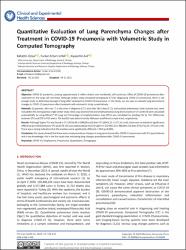Quantitative Evaluation of Lung Parenchyma Changes after Treatment in COVID-19 Pneumonia with Volumetric Study in Computed Tomography
Künye
ÖZKUL, B., URFALI, F. E., & ASİL, K. (2022). Quantitative Evaluation of Lung Parenchyma Changes after Treatment in COVID-19 Pneumonia with Volumetric Study in Computed Tomography. Clinical and Experimental Health Sciences, (12)2. pp. 528-532. https://doi.org/10.33808/clinexphealthsci.1136688 Özet
Objective COVID-19 pandemic, causing approximately 3 million deaths over worldwide, still continues. Effect of COVID-19 pneumonia after treatment on the lungs still not know. Although widely using computed tomography (CT) for diagnosing COVID-19 pneumonia, there is not enough study to determine damage of lung after treatment in COVID-19 pneumonia. In this study, our aim was to evaluate lung parenchyma changes in COVID-19 pneumonia after treatment with volumetric study, quantitatively. Methods 25 patients, who has CT at the time of diagnosis (CT1) and after 282 days (CT2), and positive polymerase chain reaction test, were included in this retrospective single center study. Total lung volüme (TLV) and emphysematous lung (ELV) volume of CT1 and CT2 were calculated automatically by using Myrian® XP-Lung and Percentage of emphysematous area (PEA) was calculated by dividing ELV by TLV. Differences between CT1 and CT2 in PEA and in TLV and ELV was determined by Wilcoxon and Paired sample t test, respectively. Results Although higher TLV was found in CT2 (4216,43 ± 1048,99 cm3) than CT1 (3943,22 ± 1177,16 cm3), there was no statistical significance difference (p=0.052) between CT1 and CT2. ELV was statistically (p=0.017) higher in CT2 (937,22 ± 486,89 cm3) than CT1 (716,26 ± 471,65 cm3). There was a strong indication that the medians were significantly different in PEA (p=0,009). Conclusions Our study showed that there were emphysematous changes in lung parenchyma after COVID-19 pneumonia with CT, quantitatively and in our knowledge, this is the first study that evaluating lung changes quantitative after COVID-19 pneumonia. .

















